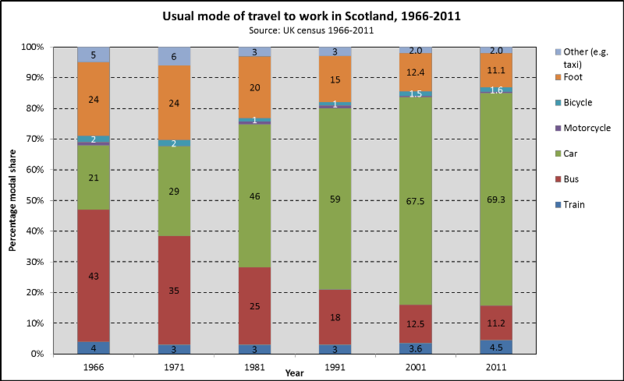Scottish trends
Trends in modes of travel to work in Scotland, 1966-2011
Click on graph to expand
Trends in mode of travel to work in Scotland can be followed over a 45-year period using the census.
In this period, the use of a car to commute to work has risen significantly, from 21% in 1966 to 69% in 2011. In contrast, commuting on foot and by bus have reduced dramatically. In 1966, commuting by bus was the most popular method of travelling to work (43%) but by 2011 only 11% of commuters used this method. The proportion of employed people commuting on foot halved in the period from 24% to 11%. Train use, which in this graph includes travelling by the underground, increased slightly between 1991 to 2011 (from 3% to 4.5% of commuters). Bicycle use remained low and static over most of the period with a very marginal increase from 1.5% in 2001 to 1.6% in 2011.
Notes
The data shown above are sourced from UK Censuses conducted in 1966, 1971, 1981, 1991, 2001 and 2011. This analysis is based on responses from employed adults regarding their usual mode of travel to work.
Figures from 1981 onwards exclude those who worked at home (who were not identified separately in the 1966 and 1971). Commuting by underground is aggregated within train use, taxi use is shown in the ‘Other’ category. Data for 2001 and 2011 include all people aged 16 to 74 in employment in the week before the census (excluding full-time students). Sources – Table 12.18, STS No. 28 2009 edition, Table ST204 (2001 Census) and Table QS701SC (2011 Census)
The census question is thought to underestimate levels of walking, as the question asks for the main mode of travel used on a commuting journey and multi-modal journeys which include walking but not as the main mode of travel are not accounted for.
A recent GCPH report, Pedestrian and cyclist casualty trends in Scotland, as well as providing a detailed analysis of casualty trends, outlines trends in modes of travel to work and study in Scotland (see Chapter 4 and Appendix A).
Additional Resources
-
ResourceThursday, 6 December 2012
Going to Gothenburg: Reflections on a Study Visit
-
ResourceWednesday, 18 May 2011
Hands Up Scotland 2010
Results from the largest national dataset to look at mode of travel to school across Scotland -
ResourceFriday, 1 October 2010
Moving in the right direction?
Findings from a review of transport policy in Scotland -
ResourceSaturday, 21 August 2010
Active Travel - Video
Qualitative research has been undertaken in order to better understand how and why people currently travel as they do and to explore the scope for encouraging growth in alternatives to car travel. -
ResourceTuesday, 1 September 2009
Attitudes toward active travel in Glasgow
Findings from a qualitative research project exploring how and why people travel in and around Glasgow -
ResourceThursday, 1 November 2007
How can transport contribute to public health?
A briefing paper discussing the evidence regarding the potential of transport to improve health, reduce inequalities and improve sustainability








